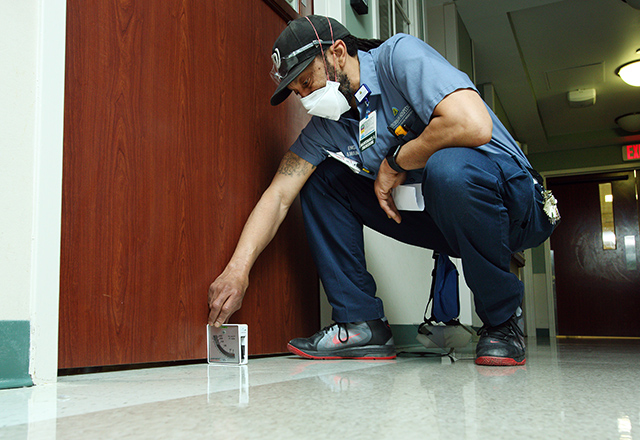Engineers, carpenters, painters and other facilities workers throughout the Johns Hopkins Health System have been working at a frenetic pace to prepare Johns Hopkins hospitals for COVID-19 patients.
They are adding ductwork and HEPA (high efficiency particulate air) filters to convert regular patient rooms to ones with negative air pressure suitable for patients with the highly infectious coronavirus.
They are quickly building anterooms where clinicians can safely don or doff their protective gear before treating patients who were diagnosed with COVID-19 or are waiting for test results.
They are setting up tents for COVID-19 testing, removing chairs from hospital cafeterias to promote physical distancing, and putting up signs telling people which entrance doors are locked.
“I’ve worked at Hopkins for 27 years,” says Cheryl Koch, vice president for operations and facilities at Johns Hopkins Bayview Medical Center. “We’ve certainly had lots of challenges but I would say this one has probably pulled the most people together in the shortest amount of time. Everybody has been working long hours trying to make sure we’re ready for the next phase of what’s coming.”
Because of these efforts, The Johns Hopkins Hospital is on track to add negative pressure capability to as many as 800 adult and pediatric patient beds, says Gregory Bova, senior engineering project manager for the health system.
The other Maryland and Washington hospitals — Suburban Hospital, Sibley Memorial Hospital, Howard County General Hospital and the Johns Hopkins Bayview Medical Center — are adding more than 200 COVID-19 rooms between them.
“It’s been all hands on deck,” says Caroline Shafa, vice president of operations at Sibley Memorial Hospital. “I think it’s unprecedented for everyone.”
Johns Hopkins All Children’s Hospital has 14 negative pressure rooms for treating children with infectious diseases like tuberculosis, and by mid-April had seen just a handful of COVID-19 patients, says Larry Green, safety director for the Florida hospital.
“Every week we consider the need to convert another unit to COVID capability,” says LeighAnn Sidone, chief nursing officer of the 228-bed Suburban Hospital. “We have a plan to stay a unit ahead so we are prepared if the volume rises.”
Adds Suburban President Jacky Schultz: “I feel like we’re in as good a shape as we can be for right now. We’re trying to get ahead of the terrible curve. It’s just a question of how high the water will rise.”
 Suburban Hospital mechanic Michael Mills tests a room for negative air pressure in order to contain the coronavirus that causes COVID-19.
Suburban Hospital mechanic Michael Mills tests a room for negative air pressure in order to contain the coronavirus that causes COVID-19.
Preparing for COVID-19 Patients
The health system began preparing for COVID-19 patients in January, says Bova. For some of that time, its hospitals have been eerily empty — nonemergency surgeries and treatments have been suspended since March 18.
Hospitals have been converting one unit at a time, often starting with medical intensive care units and medical surgery units and moving to surgical intensive care units and post-anesthesia care units. A key step is converting the air filtration system so that it removes more air than it lets in, creating negative pressure that prevents the escape of contaminated air.
“Most patient rooms are designed with positive pressure, so air flows out of the room to keep germs away from patients,” explains Ray Littleton, facilities manager for Howard County General Hospital. “Trying to go after the fact and make them negative has been a challenge.”
The switch requires intense filtration, usually with HEPA filters, to ensure the air is scrubbed clean of the virus before it flows out. Also required are specialized anterooms where staff can put on and take off personal protective equipment without risk of infection to themselves or anyone else.
Greg Bova and his facilities team at The Johns Hopkins Hospital have built more than 30 donning rooms and 30 doffing rooms since mid-February, he says. Design and construction takes less than a week and involves about 20 people, including carpenters; painters; electricians; heating, ventilation and air conditioning specialists; movers and technology experts.
“We’re building walls and doors and we’re putting in air pressure monitors, HEPA filter fan units and fan units,” he explains.
The filtration systems vary by hospital and even by room.
Most Johns Hopkins hospitals have at least a few rooms that operate at negative pressure or can easily convert to it for patients with contagious illnesses. The Johns Hopkins Hospital created 136 airborne biocontainment rooms in 2001 amid concerns about smallpox or anthrax bioterrorism attacks, and 22 more in 2004 during the SARS pandemic. In 2015, at the start of the Ebola pandemic, it added a biocontainment unit that also has special air handling capability.
But as more patients with COVID-19 fill Johns Hopkins hospital beds, facilities employees have had to move beyond the usual types of conversions. Littleton’s team in Howard County, for example, found a way to use a single HEPA filter for three rooms. “We’re taking larger construction HEPA machines and installing them with ductwork in the ceiling,” he says.
And Bova modified a portable HEPA filter fan unit and then connected it to a return device, so it filters the air before recirculating it back into the building.
When the coronavirus crisis ebbs, the modifications will remain, allowing hospitals to switch room pressure between positive and negative, as needed. The anterooms will stay as well, says Bova.
But there will be a key difference: “We’ll open the doors so people can easily go in and out.”
